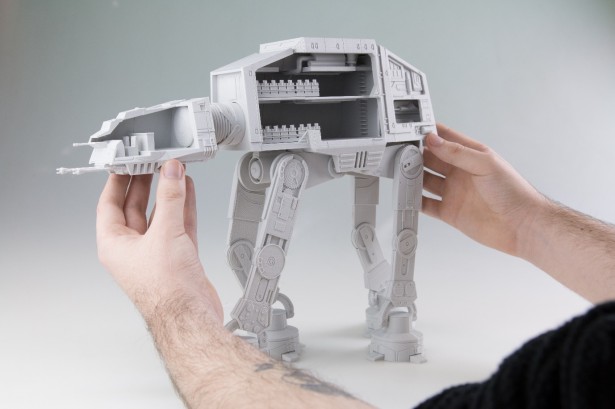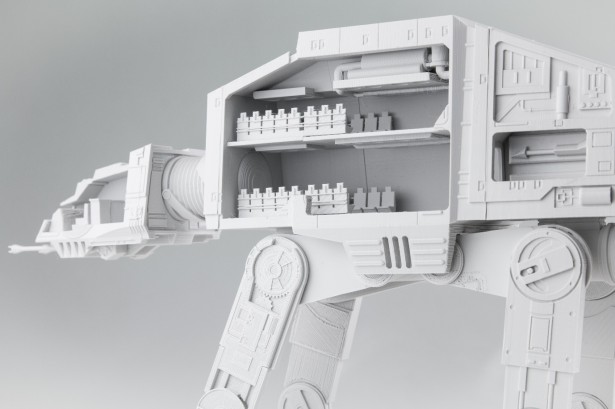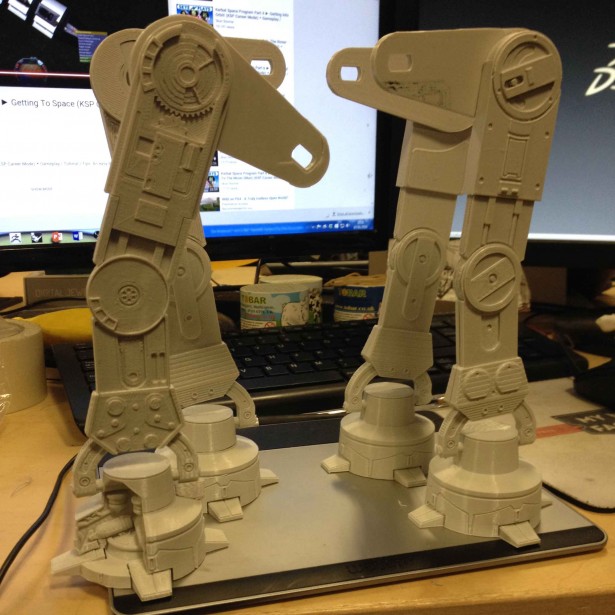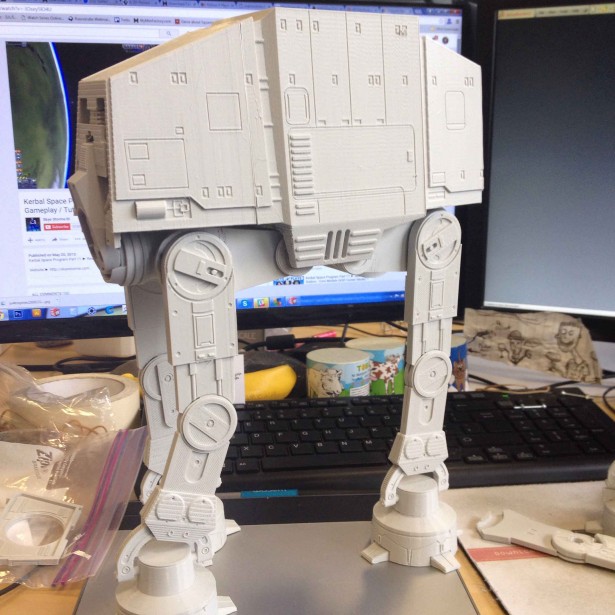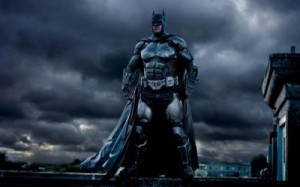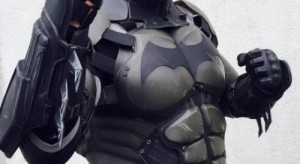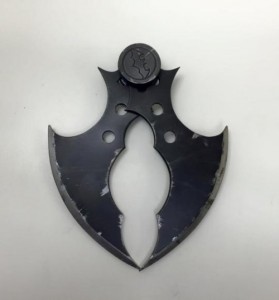Archived Media
Monday, February 21, 2016
Designing for 3D Printing with Cosplay Artist Kirby Downey
Tuesday, October 27, 2015
Canada must sharpen its 3-D printing vision
Edward Burtynsky is an internationally renowned photographer and a co-founder of Think2Thing, a Toronto-based 3-D prototyping, modelling and design atelier.
The quest for the fabled Northwest Passage inspired nautical explorers of the 19th century, such as John Franklin, to look globally for innovative new paths for trade and economic growth. Similarly, a new wave of innovators are seeking to break ground in the areas of design and production and have found previously unimaginable opportunities through 3-D printing, allowing them to create anywhere and any time. How fitting that these new technologies have allowed us to link innovators across the centuries through perfectly replicating the bell of the recently recovered HMS Erebus, one of the Franklin Expedition’s two ships.
Three-dimensional technology itself is a wonder, producing digital scans of objects one layer at a time through “additive manufacturing.” It has the potential to transform virtually every economic sector – including automotive, aerospace, biomedical, information and communications technology, architecture, culture and design – and can ultimately change what we make, how we make it and where it is made. Industry leaders are looking into how it can and should be harnessed by Canadian businesses seeking to compete in the ever-changing global marketplace.
Innovation in the 3-D printing space relies on the best in art, engineering and design – all strengths in ample evidence here in Canada. As Canadian manufacturing faces an uncertain future in a world of increasingly globalized and intensely competitive supply chains, 3-D printing has the potential to leverage our country’s competitive advantages. When combining our nation’s talent pool with progressive innovation ecosystems, a skilled manufacturing work force, and great university researchers – such as those from Ryerson’s Advanced Manufacturing, Design and 3D Printing Lab – Canada can be at the forefront of this 3-D printing revolution.
As a fine art photographer, I may be an odd champion of the virtues and potential of 3-D printing. But in many respects, 3-D printing is essentially Photography 3.0. From film to digital to three-dimensional form, photography’s capacity to capture moments, objects and places has expanded exponentially, opening up exciting new vistas for the future of this genre.
Yet, 3-D printing’s potential goes far beyond simply moving photography to the next level. According to a 2013 study by Deloitte, 3-D printing is projected to have a greater impact on the world over the next 20 years than all of the innovations of the industrial revolution combined. Already, 3-D printing is being used by industrial designers and artists to produce visualizations and prototypes hitherto unimaginable. In manufacturing, Boeing has adopted 3-D printers for more than 200 parts on 10 different types of aircraft. NASA has tested 3-D printers in space to print tools and spare parts on the International Space Station. In France, a violinist has produced the “3Dvarius,” the first fully playable 3-D-printed violin.
3-D technology is also enabling businesses to shift away from traditional practices, such as mass production to manufacturing on demand. Given the growing consensus that our country’s economy needs to become less reliant on sectors that are at the mercy of global demand cycles, it could well be that 3-D printing technology will become Canada’s 21st-century version of the Northwest Passage – opening new opportunities worldwide.
However, a world-class 3-D printing and imaging “cluster” in Canada will not happen without a strategy, capital and resources to support entrepreneurship, research and adoption in this nascent field. With a new Liberal majority government expressing interest in making an investment toward innovation to allow traditional Canadian industries to become more competitive and successful, we need to ensure that investment in 3-D technology adoption is a part of the Canadian innovation agenda.
It is important to remember that as fascinating as new technologies such as 3-D printing are, if they are not actually used, there is no innovation. Our national strategy must recognize that innovation is not just about creating technologies, products and services, but also about promoting their adoption to drive innovation, productivity and growth. If anything, the need to innovate is even more pronounced today. As so-called “disruptive innovations” sweep across the competitive landscape, separating winners from losers, the question becomes whether Canada will be a disrupting early adoptor or a disrupted late follower.
Meanwhile, the 3-D replica of the Erebus bell, on display since last January at the Royal Ontario Museum, is a powerful reminder of the spirit of innovation and adventure that inspired Sir John Franklin and his men. Let it ring again to usher in a new age of Canadian design and manufacturing innovation.
Tuesday, October 20, 2015
Guy creates handheld railgun with a 3D-printer
An ambitious maker has built a partly 3D-printed railgun that can fire aluminum or graphite projectiles at over 250 meters per second (560 mph). No, this isn’t Quake, but it’s no janky, all-plastic gun, either. The “handheld” weapon houses six capacitors that weigh 20 pounds and deliver over 1,800 joules of energy per shot. And it indeed works just like a full-sized railgun, using parallel electrodes to fire an “armature” bullet. The creator, David Wirth, added an Arduino Uno R3 to monitor charging levels, temperature and other factors, and tweaked the rails after he noticed “plasma damage.”

The resulting design was complex enough that he even made a 3D CAD drawing that would do DARPA proud (above). The test shots with graphite and aluminum projectiles were far less lethal than a regular gun, as you can see in the videos below. Nevertheless, the aluminum “bullet” still put a half-inch dent in the steel-backed plywood target, and the graphite projectile “probably just vaporized,” according to the Wirth.
WXPR-1 Test 3 – Highspeed (YouTube Video)
Friday, September 11, 2015
Canadian doctor uses 3D printing to help with Gaza’s medical supplies shortage
Dr. Tarek Loubani has created a stethoscope using 3D printing
By Ainsley Smith | Good News
Loubani is an emergency medicine doctor from London, Ont., and first got the idea for creating the cost effective stethoscope after he spent time helping at the main hospital in Shifa, Gaza City, while a war between Israel and Palestinian militants took place in 2012.
As the war continued for eight days, wounded Palestinians flooded into the hospital and doctors were limited to the supplies they had on hand, working with only two stethoscopes, The Associated Press reports.
Shortly after he returned back to Canada, Loubani was playing with his nephew’s toy stethoscope and he noticed that a functioning stethoscope’s ear tube might not need to be made from stainless steel and perhaps there was a cheaper alternative available.
After years of research, designing and testing, Loubani’s plastic prototype was born.
Loubani’s stethoscope is the latest of many devices developed as part of the Glia Project, which is aimed at bringing lower-priced medical supplies to the Gaza Strip and other regions that are low in medical resources.
Dr. Jonathan Dreyer, research director of emergency medicine at the Schulich School of Medicine and Dentistry at the University of Western Ontario, has used the Gila stethoscope on many of his patients an he said that it is a “high quality instrument.”
“I have used it on many of my patients in the emergency department and can attest to the fidelity of the sound,” he said.
Loubani is now introducing his stethoscope to doctors in Gaza, but it is challenging as doctors in the region don’t typically use stethoscopes. He hopes that the low cost and practicality of the instrument will encourage doctors in improvised areas to seriously consider using it.
“I’m very happy that patients in Gaza and patients all around the world can now, with these stethoscopes, receive the best care possible,” Loubani said.
Loubani’s stethoscope can be made for the low cost of $2.50, which is much cheaper than top-of-the-line stethoscopes that cost $200 or more.
Friday, August 28, 2015
“It’s amazing and I love the colours! I’m going to use it for as many things as I can!”

A little girl got the surprise of her life when she opened a box containing a 3D-printed arm, allowing her to use both of her arms for the very first time.
Isabella Jenkins from Bristol, England, was given a pink and purple arm by volunteers at e-NABLE, a nonprofit group that pairs those in need of a 3D-printed hand with people eager to build one.
The eight-year-old girl’s arm was made by Stephen Davies, a tester and producer who happens to have his own 3D-printed arm, e-NABLE reports.
“It’s amazing and I love the colours!” Isabella told e-NABLE. “I’m going to use it for as many things as I can!”
Davies traveled from Wales to personally deliver the 3D-printed arm to his first recipient. He posted the sweet Isabella’s reaction on YouTube.
In the video, Isabella is seen tearing the box open and beaming when she realizes what’s inside. She immediately tries it on and starts to wiggle her fingers before picking up a figurine on the windowsill.
“I will be buzzing for weeks just from Isabella’s smile,” Davies wrote in his blog. “Truly nectar for the soul.”
And according to her father, no one in the world has a 3D-printed arm that’s quite as advanced as Isabella’s. “It’s produced through the state of art 3D printing and features everything from carbon fibre to loom bands believe or not!” Her father, Matthew, wrote on Facebook .
Matthew also mentions that Isabella’s arm isn’t quite a prosthetic, as it relies on the use of muscles “previously un-relied upon.”
“It’s aim is to boost confidence and take away awkward unwanted situations and questions and replace them with ‘how cool is that’ remarks, which it certainly has so far,” her father wrote.
Right after Isabella received her gift, she “proudly strutted” around a local supermarket store “wanting the world to see it.”
The world is now your oyster, Isabella!
Tuesday, June 23, 2015
“Insane Batman Cosplay for ‘Arkhan Origins’!”
By Jordan Zakarin | Yahoo Movies – Tue, 23 Jun, 2015 8:05 PM EDT
Julian Checkley as Batman (Facebook/Kamil Krawczak)
This new Batman cosplay is so good, it’s scary. Seriously, the costume’s got working flamethrowers.
The hyper-realistic Dark Knight armor above (and below) is the masterwork of Julian Checkley, an Irish effects specialist and cosplay legend who has long been known for his Star Wars cosplay. Several years ago, he made a very impressive Bane costume inspired by Christopher Nolan’s film The Dark Knight Rises, but this new cosplay is actually inspired by the video game Batman: Arkham Origins.
The costume is incredibly realistic, with folding Batarangs, sharp gauntlets, thick chest armor, and, once again, a working flamethrower. It was made by 3D printer over the course of a month, which is both impressive and scary, because we’re getting to the point that absolutely anyone can make working superhero technology in their own homes.
Click over to his studio’s Facebook page for a closer look at this costume, including some of the highly dangerous looking gear, like the Batarangs below.
(Order 66 Creatures and Effects/Facebook)

